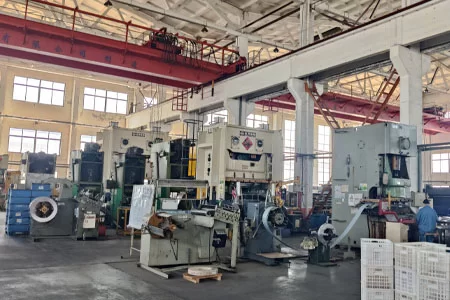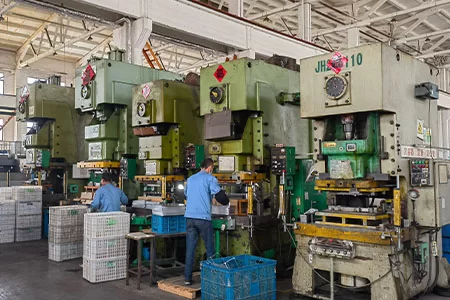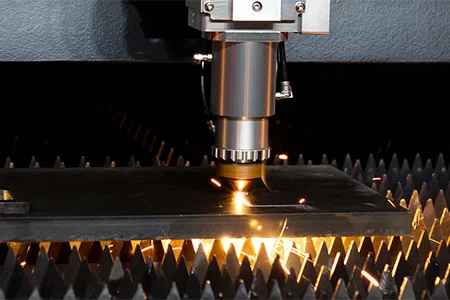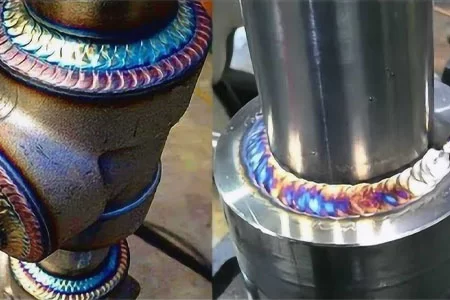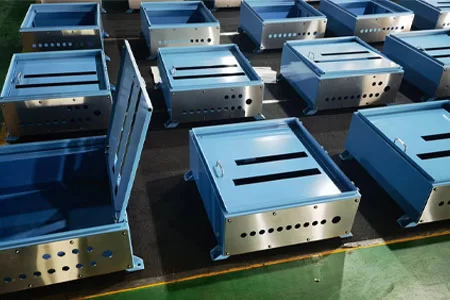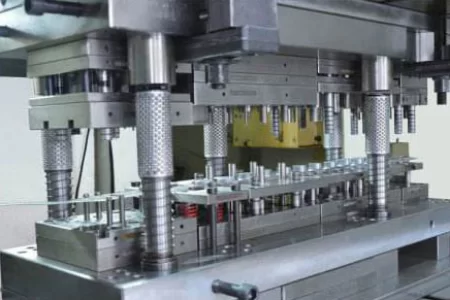This extensive guide covers metal deep drawing fundamentals, production techniques including mold design and process combinations, detailed material considerations, diverse product applications (excluding high-end sectors), and critical factors for select

Gain comprehensive insights into metal deep drawing—from process flows and mold design to material requirements, product applications, and partner selection tips.
Metal Deep Drawing: A Definitive In-Depth Guide to Production, Materials, Applications, and Partner Selection
-
Home>
-
Blog>
-
Technology>
Metal Deep Drawing: A Comprehensive Guide
Metal Deep Drawing: A Comprehensive Guide
Metal deep drawing is a crucial metal forming process widely used in manufacturing industries. This comprehensive guide explains metal deep drawing from the ground up—from its basic definition and production methodologies (including mold design, process flows, and combinations of processes) to in-depth material considerations, diverse product applications (excluding high-end sectors such as aerospace and nuclear power), and essential factors for selecting a reliable deep drawing contract manufacturing partner. Whether you're an engineer, production manager, or industry professional, this article will provide you with the detailed knowledge necessary to optimize your manufacturing process and achieve superior quality.
1. Understanding Metal Deep Drawing
Metal deep drawing is a metal forming process that transforms a flat sheet of metal into a hollow, typically cylindrical or box-like shape, by subjecting it to a series of controlled deformations. This process is commonly used for manufacturing items such as kitchen sinks, automotive components, and various household appliances. The "deep" in deep drawing refers to the depth of the drawn part relative to its diameter; typically, the process is considered "deep" when the drawn depth is at least twice the blank's diameter.
1.1 Definition and Process Overview
In metal deep drawing, a blank (a flat piece of metal) is clamped around its periphery between a blank holder and a die. A punch then pushes the blank into the die cavity. As the blank is forced into the die, it undergoes plastic deformation and gradually forms into the desired shape. The process involves both bending and stretching of the metal, which is why material selection and process control are critical. The ideal deep drawing process minimizes thinning of the material and avoids defects such as wrinkles, tears, or earing (uneven flange formation).
The process begins with an initial blank, which is cut from a coil or sheet. The blank is then subjected to a series of drawing operations—sometimes in multiple stages—to achieve the final deep drawn shape. Key process parameters include the blank holder force, the punch speed, and the lubrication applied to minimize friction. Modern deep drawing is enhanced by computer numerical control (CNC) systems that allow precise control over these parameters.
1.2 Historical Background and Applications
Metal deep drawing evolved as a cost-effective method for producing complex hollow components. Traditionally used in the production of household items, the process has since expanded into a wide range of applications—from automotive and packaging to electronics and kitchenware. Its ability to produce uniform wall thickness and high-quality surfaces makes it a preferred method in many mass-production environments.
1.3 Advantages of Metal Deep Drawing
Some of the key advantages include:
- Material Efficiency:
Minimal waste is generated, as the process forms the part from a single blank.
- High Production Rates:
Deep drawing can be performed at high speeds, especially when combined with automation.
- Consistency:
CNC technology ensures that each part is produced with consistent dimensions and quality.
- Cost-Effectiveness:
Low tooling costs compared to stamping or other forming processes make it economical for large-scale production.
1.4 HULK Metal's Service Capabilities
When it comes to metal deep drawing, companies like HULK Metal specialize in delivering high-precision, high-quality components. Their service is focused on utilizing advanced deep drawing technologies to meet demanding production requirements. If any quality issues arise or if there are shipment discrepancies, their after-sales service is dedicated solely to handling returns, exchanges, or replenishments for products with quality problems or insufficient quantities.
1.5 Summary of Metal Deep Drawing Definition
In summary, metal deep drawing is a sophisticated forming process that transforms flat metal sheets into complex, hollow shapes with high precision and efficiency. The process relies on controlled deformation using a punch, die, and blank holder, and its success depends on precise control of process parameters and high-quality materials. Its advantages make it indispensable in modern manufacturing, where consistency, speed, and cost-efficiency are paramount.
2. Production-Related Knowledge: Molds, Process Flow, and Process Combinations
A thorough understanding of the production aspects of metal deep drawing is essential for achieving high-quality results. This section covers everything from mold design and process flows to the integration of different forming processes, along with common issues and their solutions.
2.1 Overview of Production Techniques
Metal deep drawing production starts with the design and fabrication of molds. The mold is the heart of the deep drawing process, determining the final shape of the product. The primary components of a deep drawing mold are the die, punch, and blank holder. Each part plays a critical role:
- Die:
The cavity into which the metal is drawn.
- Punch:
The tool that pushes the metal blank into the die.
- Blank Holder:
A mechanism that controls the flow of the metal during the drawing process to prevent wrinkles.
The production process can be performed in one or multiple drawing stages, depending on the complexity of the part and the depth of the draw.
2.2 Mold Design and Its Importance
The design of the mold has a significant impact on the quality of the deep drawn component:
- Die Geometry:
The shape and dimensions of the die directly influence the final product's dimensions and surface quality. The die must be designed to minimize stress concentrations that can lead to material failure.
- Punch Profile:
The shape of the punch is tailored to match the die cavity, ensuring a smooth transition of the metal. A well-designed punch minimizes friction and wear.
- Blank Holder Force:
The blank holder must exert sufficient force to control metal flow without causing excessive thinning or tearing.
- Clearance:
The gap between the punch and die is critical; too little clearance can cause high friction, while too much clearance can lead to wrinkles or uneven material distribution.
Engineers use advanced computer-aided design (CAD) and finite element analysis (FEA) software to optimize mold design. These tools simulate the deep drawing process, allowing for adjustments to reduce the risk of defects such as tearing, wrinkling, or uneven wall thickness.
2.3 Process Flow in Metal Deep Drawing
The deep drawing process typically follows a systematic flow:
1. Blank Preparation:
The process begins with cutting the metal sheet into blanks of appropriate size. Quality control at this stage ensures that each blank is free from defects.
2. Blank Holding:
The blank is positioned on the die and secured by the blank holder.
3. Drawing:
The punch moves downward at a controlled speed, pushing the blank into the die cavity. The blank undergoes plastic deformation, forming the desired shape.
4. Redrawing
(if necessary): For parts with high depth-to-diameter ratios, the process may require multiple drawing stages. Intermediate annealing may be used between stages to restore ductility.
5. Trimming:
After the deep drawing is complete, excess material is trimmed off to produce the final product dimensions.
6. Finishing:
Surface treatments, such as polishing or coating, are applied to enhance the appearance and corrosion resistance of the part.
7. Inspection:
The finished component undergoes rigorous quality control, including dimensional verification and surface integrity checks.
2.4 Integration of Process Combinations
Deep drawing is often combined with other metal forming processes to produce more complex parts. Some common combinations include:
- Drawing and Redrawing:
Used for parts that require deep draws, this method involves multiple drawing operations with intermediate annealing.
- Drawing and Ironing:
After deep drawing, ironing can be applied to further thin the walls of the component and achieve a uniform wall thickness.
- Drawing and Stamping:
In some cases, deep drawn parts are later stamped or trimmed to create additional features such as flanges or holes.
- Drawing and Piercing:
Piercing operations may be integrated to create openings or cutouts within the drawn part.
- Drawing with Stretching:
Stretch forming can be combined with deep drawing to achieve more complex geometries.
These process combinations allow manufacturers to produce parts with intricate shapes and high precision, even when a single forming process would be insufficient.
2.5 Common Production Issues and Their Solutions
Despite the advancements in technology, several challenges can occur during metal deep drawing:
- Wrinkling:
Wrinkles occur when the metal flows unevenly. This can be controlled by adjusting the blank holder force and optimizing die design.
- Tearing:
Excessive thinning or improper blank holding can lead to tears. Reducing drawing speed and using intermediate annealing can mitigate this risk.
- Earing:
Earing is the uneven formation of flanges around the edge of the part, typically caused by anisotropy in the metal. Adjusting the blank shape and material properties can reduce earing.
- Springback:
The elastic recovery of the metal can alter the final dimensions. Compensation techniques such as over-bending help account for springback.
2.6 Solutions Through Advanced Technologies
Advanced simulation tools play a vital role in solving production challenges. Finite element analysis (FEA) allows engineers to simulate the deep drawing process, predicting stress distributions and deformation patterns. This predictive capability enables adjustments to process parameters before actual production, reducing the likelihood of defects.
Real-time monitoring systems integrated with CNC controls provide continuous feedback on key parameters, enabling operators to make dynamic adjustments during production. Regular calibration and preventive maintenance further ensure that the equipment remains within optimal operating conditions.
2.7 The Role of Production Equipment
Modern production equipment for metal deep drawing is designed for high-precision and high-volume output. While specific equipment brands are not disclosed, these machines are characterized by:
- Robust Clamping Systems:
Ensuring the blank remains secure during the drawing process.
- High-Torque Motors:
Providing the force necessary for deep draws, even in multi-stage operations.
- Advanced CNC Controls:
Offering precise control over drawing speed, force, and punch displacement.
- Integrated Sensors:
Monitoring parameters such as pressure, temperature, and material deformation in real time.
2.8 HULK Metal's Service Capabilities in Deep Drawing Production
HULK Metal is known for its expertise in metal deep drawing. Their facilities are equipped with cutting-edge deep drawing machines that combine high-precision CNC controls with robust production capacity. HULK Metal focuses on delivering consistent, high-quality components. Should any quality issues or shipment discrepancies occur, their after-sales service is dedicated solely to managing returns, exchanges, or replenishments for defective or under-shipped products.
2.9 Production-Related Knowledge Summary
To summarize, the production of metal deep drawn components involves a series of well-defined steps—from mold design and blank preparation to multi-stage drawing and finishing. By integrating advanced technologies such as CNC automation and FEA simulations, manufacturers can optimize process parameters and solve common issues such as wrinkling, tearing, and springback. These integrated production practices ensure high-quality output, making metal deep drawing a highly efficient and cost-effective method for mass production.
3. Material-Related Knowledge: Types and Requirements
The choice of material is a critical factor in metal deep drawing. The material must possess the appropriate balance of ductility, strength, and surface quality to undergo significant deformation without failure. In this section, we examine the various materials used in deep drawing and discuss the requirements for successful forming.
3.1 Material Selection Criteria
Successful deep drawing depends on several key material properties:
- Ductility:
The ability to undergo large plastic deformations without cracking.
- Strength:
Sufficient strength is required to maintain the shape of the drawn part.
- Thickness:
Uniform sheet thickness is essential for predictable drawing behavior.
- Surface Quality:
A smooth, defect-free surface minimizes the risk of tearing and improves the final appearance.
- Work Hardening:
Materials with moderate work hardening are preferred to prevent uneven deformation.
3.2 Common Materials in Deep Drawing
3.2.1 Aluminum
- Advantages:
Aluminum is lightweight, highly ductile, and offers excellent corrosion resistance. It is ideal for applications requiring complex shapes with a high-quality surface finish.
- Requirements:
Aluminum used in deep drawing must have consistent thickness and a well-controlled temper to ensure uniform deformation. Lubrication and proper blank holder force are critical to prevent over-thinning.
3.2.2 Stainless Steel
- Advantages:
Stainless steel provides high strength and excellent resistance to corrosion. It is used where durability and aesthetic appeal are important.
- Requirements:
Due to its lower ductility compared to aluminum, deep drawing stainless steel requires higher forming forces and precise control to avoid cracks. Material quality and consistency are paramount.
3.2.3 Brass and Copper
- Advantages:
These materials are valued for their electrical conductivity and attractive finishes, making them suitable for decorative and functional components.
- Requirements:
Brass and copper tend to work-harden, so deep drawing requires careful control of drawing speed and force. Specialized lubricants are often necessary to reduce friction and prevent tool wear.
3.2.4 Mild Steel
- Advantages:
Mild steel is widely used for its cost-effectiveness and good formability. It is common in industrial applications where durability is critical.
- Requirements:
Mild steel should be used in a controlled temper to ensure it can be drawn without cracking. Post-forming treatments, such as coating or painting, may be needed to enhance corrosion resistance.
3.3 Surface Quality and Finishing Requirements
Deep drawing not only forms a part but also affects its surface characteristics. The material should have a smooth, defect-free surface to begin with. Post-drawing, surface treatments such as polishing, anodizing, or powder coating may be applied to improve both appearance and performance.
3.4 Temperature and Lubrication Considerations
During deep drawing, temperature control is critical. The material must remain within an optimal temperature range to allow for sufficient ductility without causing excessive thinning. Lubricants are applied to reduce friction between the material and the forming tools, ensuring smooth deformation and prolonging tool life.
3.5 Material Testing and Quality Assurance
Quality assurance begins with rigorous testing of raw materials. Manufacturers perform tensile tests, hardness tests, and surface inspections to ensure that the material meets the required specifications for deep drawing. Consistent material quality is essential for achieving uniform results in production.
3.6 Summary of Material-Related Knowledge
In conclusion, the choice of material is a cornerstone of successful metal deep drawing. Understanding the properties and requirements of materials like aluminum, stainless steel, brass, copper, and mild steel allows manufacturers to optimize process parameters and achieve high-quality, defect-free components. The integration of effective lubrication, temperature control, and post-forming surface treatments further enhances material performance, ensuring that the final product meets stringent quality standards.
4. Product-Related Content: Applications of Metal Deep Drawing
Metal deep drawing is used in the production of a wide array of components across various industries. In this section, we will discuss product applications by category. For each category, we list at least five representative products. (Note: High-end industries such as aerospace and nuclear power are excluded.)
4.1 Server-Related Products
Deep drawing is widely used in the technology sector to produce components that offer both structural integrity and aesthetic appeal. Common server-related products include:
- Racks:
Deep drawn racks that support and organize server equipment.
- Cabinets:
Secure enclosures for housing servers and network devices.
- Brackets:
Mounting brackets for positioning servers and peripherals.
- Trays:
Flat, drawn trays for organizing and accessing components.
- Cable Management Systems:
Deep drawn panels and accessories designed to route and secure cables.
- Blank Panels:
Pre-formed panels used in the assembly of server cabinets.
- Ventilation Panels:
Components with built-in perforations to enhance cooling in server systems.
4.2 Trailer-Related Products
In the transportation industry, metal deep drawing is used to produce durable and robust components for trailers. Examples include:
- Trailer Frames:
Structural frames formed with precise deep drawing processes.
- Side Panels:
Curved panels that form the sides of trailers.
- Underbody Shields:
Protective covers for the trailer's undercarriage.
- Cab Enclosures:
Components for trailer cabs designed for strength and aesthetics.
- Reinforcement Bars:
Deep drawn support elements that enhance structural rigidity.
- Roof Panels:
Curved panels that form the roof of a trailer.
- Door Frames:
Precisely formed frames for trailer doors ensuring a secure fit.
4.3 Automotive-Related Products
Deep drawing plays a significant role in automotive manufacturing, producing components that combine functionality with visual appeal. Key automotive products include:
- Body Panels:
Hoods, doors, and fenders produced using deep drawing for uniform thickness and smooth surfaces.
- Chassis Components:
Structural parts of the vehicle frame that require precise forming.
- Exhaust Components:
Parts such as manifolds and heat shields that are formed for efficient performance.
- Interior Panels:
Dashboard frames, door sills, and trim pieces manufactured by deep drawing.
- Bumper Reinforcements:
Internally drawn components that enhance the impact resistance of bumpers.
- Grille Frames:
Deep drawn frames that add both protection and style to the vehicle front.
- Engine Covers:
Components that provide a protective casing for engine components.
4.4 Building Prefabrication-Related Products
In the construction sector, deep drawn components contribute to both structural and decorative elements of prefabricated buildings. Products include:
- Wall Panels:
Curved or flat panels used as exterior or interior cladding.
- Roofing Sheets:
Durable, deep drawn sheets that form roofs with enhanced weather resistance.
- Flooring Supports:
Structural components that serve as underlays for raised floors.
- Column Covers:
Aesthetic covers for structural columns to improve building appearance.
- Canopies:
Overhanging elements that provide shelter and add architectural flair.
- Sunshades:
Deep drawn fins or panels designed to reduce solar gain.
- Facade Elements:
Custom-designed panels that create modern building facades.
- Utility Boxes:
Pre-formed enclosures used for electrical and mechanical installations.
4.5 Additional Product Categories
Other sectors also benefit from metal deep drawing:
- Consumer Appliances:
Items such as sinks, washing machine drums, and refrigerator panels are produced with deep drawing to achieve smooth, uniform surfaces.
- Packaging Components:
Deep drawn metal containers and housings for industrial and consumer applications.
- Furniture Components:
Curved metal parts used in modern furniture design.
- Electronic Device Casings:
Enclosures for devices such as printers and scanners.
- Industrial Equipment Housings:
Protective casings and control panels for machinery.
4.6 Summary of Product-Related Content
Metal deep drawing is a versatile process that enables the production of a wide range of components. From server systems and trailers to automotive parts and building prefabrication elements, the process delivers high-quality, uniformly formed products that meet both functional and aesthetic requirements. The ability to form complex shapes with minimal material waste makes deep drawing indispensable in mass production.
5. Factors for Selecting a Metal Deep Drawing Contract Manufacturing Partner
Choosing the right contract manufacturing partner for metal deep drawing is essential for achieving consistent quality and operational efficiency. This section outlines the critical factors to consider when evaluating potential partners.
5.1 Importance of Partner Selection
A dependable partner ensures that every stage of production—from raw material selection to final inspection—is handled with expertise. The right partner can significantly improve product quality, reduce production costs, and ensure timely delivery.
5.2 Production Capacity and Equipment Capabilities
- State-of-the-Art Machinery:
The partner should operate advanced deep drawing machines with robust clamping systems, high-torque motors, and integrated CNC controls. Emphasis is on the production capacity and reliability of the equipment rather than specific brand names.
- High Throughput:
Ensure that the facility has the capacity to meet both small-batch and large-scale production orders without compromising on quality.
- Technology Integration:
Look for partners that integrate real-time monitoring systems and automation to optimize the deep drawing process and minimize defects.
5.3 Technical Expertise and Process Management
- Skilled Workforce:
A proven track record in metal deep drawing is critical. The partner should have experienced engineers and operators capable of optimizing process parameters and troubleshooting issues.
- Process Optimization:
The use of simulation software and advanced process control helps in fine-tuning the deep drawing operation. This optimization reduces common problems such as springback, wrinkling, and tearing.
- Problem-Solving:
Evaluate the partner's ability to quickly address and resolve production issues to minimize downtime.
5.4 Quality Control and Inspection Procedures
- Comprehensive Quality Checks:
The partner must employ stringent quality control measures at every stage, including raw material inspection, in-process monitoring, and final product testing.
- Non-Destructive Testing:
Techniques such as laser scanning, coordinate measuring machines (CMM), and computerized tomography (CT) scanning are essential to ensure that the final products meet the required specifications.
- Certifications:
Look for internationally recognized quality certifications (e.g., ISO 9001) as evidence of the partner's commitment to maintaining high standards.
5.5 Material Handling and Integrated Finishing
- Expert Material Management:
The partner should have extensive experience handling a variety of materials, ensuring that the deep drawing process is optimized for each material type.
- In-House Finishing Capabilities:
Integrated finishing processes such as polishing, anodizing, and powder coating streamline production and enhance the final product's appearance and durability.
- Consistency in Material Quality:
Rigorous testing of raw materials ensures uniformity, which is crucial for reliable deep drawing outcomes.
5.6 Turnaround Time and Flexibility
- Fast Turnaround:
In today's fast-paced market, quick production times are essential. The partner should demonstrate the ability to adapt to design changes and handle custom orders efficiently.
- Lean Manufacturing Practices:
Efficient workflow management and lean production processes indicate the partner's ability to meet tight deadlines without compromising quality.
- Scalability:
The partner must be capable of scaling production volumes based on demand while maintaining consistent quality.
5.7 Cost Efficiency and Transparent Pricing
- Clear and Transparent Pricing:
The pricing structure should be upfront and free of hidden costs. Evaluate whether the cost reflects the advanced technology, quality control measures, and integrated finishing services provided.
- Value for Money:
Consider the overall value offered, including potential savings from reduced material waste and improved production efficiency.
- After-Sales Support:
Companies like HULK Metal offer clear pricing along with dedicated after-sales service to manage returns, exchanges, or replenishments for quality issues or shipment discrepancies.
5.8 Communication and Customer Service
- Regular Updates:
Open lines of communication are essential. The partner should provide timely updates on production status and any issues that arise.
- Responsive Customer Service:
A dedicated customer service team that promptly addresses inquiries and resolves problems is crucial for a smooth partnership.
- Collaborative Approach:
The ability to work closely with your team and tailor solutions to your specific needs enhances the overall production process.
5.9 Certifications, Compliance, and Sustainability
- Adherence to Standards:
The partner should comply with all relevant industry standards and environmental regulations.
- Sustainable Practices:
Commitment to reducing waste and optimizing energy consumption can provide long-term benefits and align with corporate sustainability goals.
- Industry Certifications:
Certifications serve as a testament to the partner's commitment to quality and continuous improvement.
5.10 Long-Term Partnership and Innovation Potential
- Future Collaboration:
Consider whether the partner is open to long-term collaboration. A partner that invests in research and development and embraces digital manufacturing tools is better equipped to offer innovative solutions.
- Continuous Improvement:
A long-term relationship allows for ongoing process optimization and quality enhancements.
- Trust and Reliability:
The partner's track record, reputation, and commitment to mutual growth are key indicators of long-term reliability.
5.11 Summary of Partner Selection Factors
Choosing the right metal deep drawing contract manufacturing partner is a multifaceted decision. By carefully evaluating production capacity, technical expertise, quality control, material handling, turnaround time, cost efficiency, communication, certifications, and long-term innovation potential, businesses can select a partner that not only meets immediate production needs but also supports long-term growth and operational excellence.
Conclusion
Metal deep drawing is a sophisticated metal forming process that plays a pivotal role in modern manufacturing. Its ability to transform flat sheets into complex, hollow components with minimal waste and high precision makes it indispensable in industries ranging from consumer appliances to automotive parts and building prefabrication. By integrating advanced mold design, optimized production processes, rigorous quality control, and appropriate material selection, manufacturers can achieve exceptional quality and efficiency.
This guide has explored every facet of metal deep drawing:
- We began by defining the process, outlining its fundamentals, advantages, and the role of CNC technology.
- Next, we delved into production-related knowledge, discussing mold design, process flows, common issues, and the integration of different forming techniques.
- We then examined material-related considerations, detailing the properties, requirements, and challenges associated with various metals.
- Following that, we reviewed product applications across multiple industries with detailed lists of representative components for server, trailer, automotive, and building prefabrication sectors.
- Finally, we outlined the critical factors for selecting a metal deep drawing contract manufacturing partner, emphasizing production capacity, technical expertise, quality control, and more.
Manufacturers that invest in advanced deep drawing technologies, rigorous process optimization, and comprehensive quality management can achieve superior product performance and operational efficiency. Companies like HULK Metal exemplify these capabilities through their specialized services and dedicated after-sales support, ensuring that any quality issues or shipment discrepancies are promptly addressed.
By following the guidelines and best practices detailed in this guide, industry professionals can optimize their deep drawing processes and select the ideal contract manufacturing partner to support their production needs. Ultimately, mastering metal deep drawing is essential for staying competitive in today's dynamic manufacturing landscape.
Article Navigation
Article Navigation
Industries
Foundries
-

November.21, 2024
HULK Metal Stamping Factory Show
READ MORE
-

October.18, 2024
HULK Metal Fabrication
READ MORE
-

October.25, 2024
Comprehensive Guide to Sheet Metal Cutting: Methods, Materials, and Choosing the Right Partner
READ MORE
-

September.30, 2024
Comprehensive Understanding of Sheet Metal Welding
READ MORE
-

September.27, 2024
8 Types of Sheet Metal Assembly Technology and Their Processes and Applications
READ MORE
-

September.24, 2024
The Most Comprehensive Introduction To Metal Stamping Dies
READ MORE



